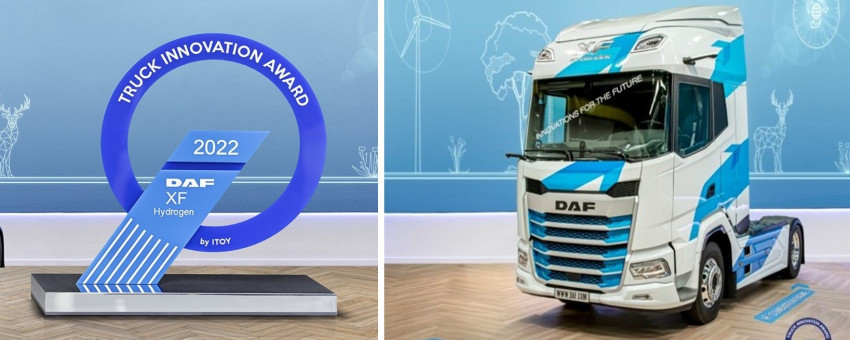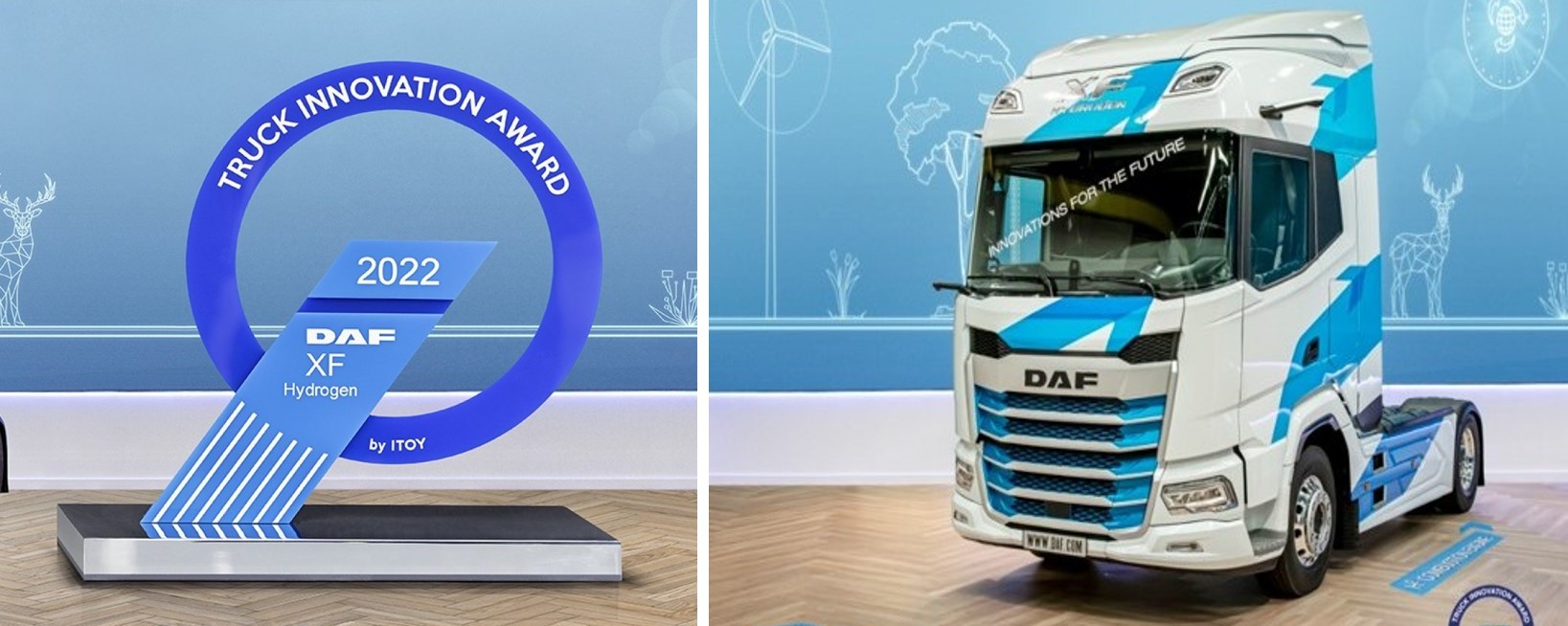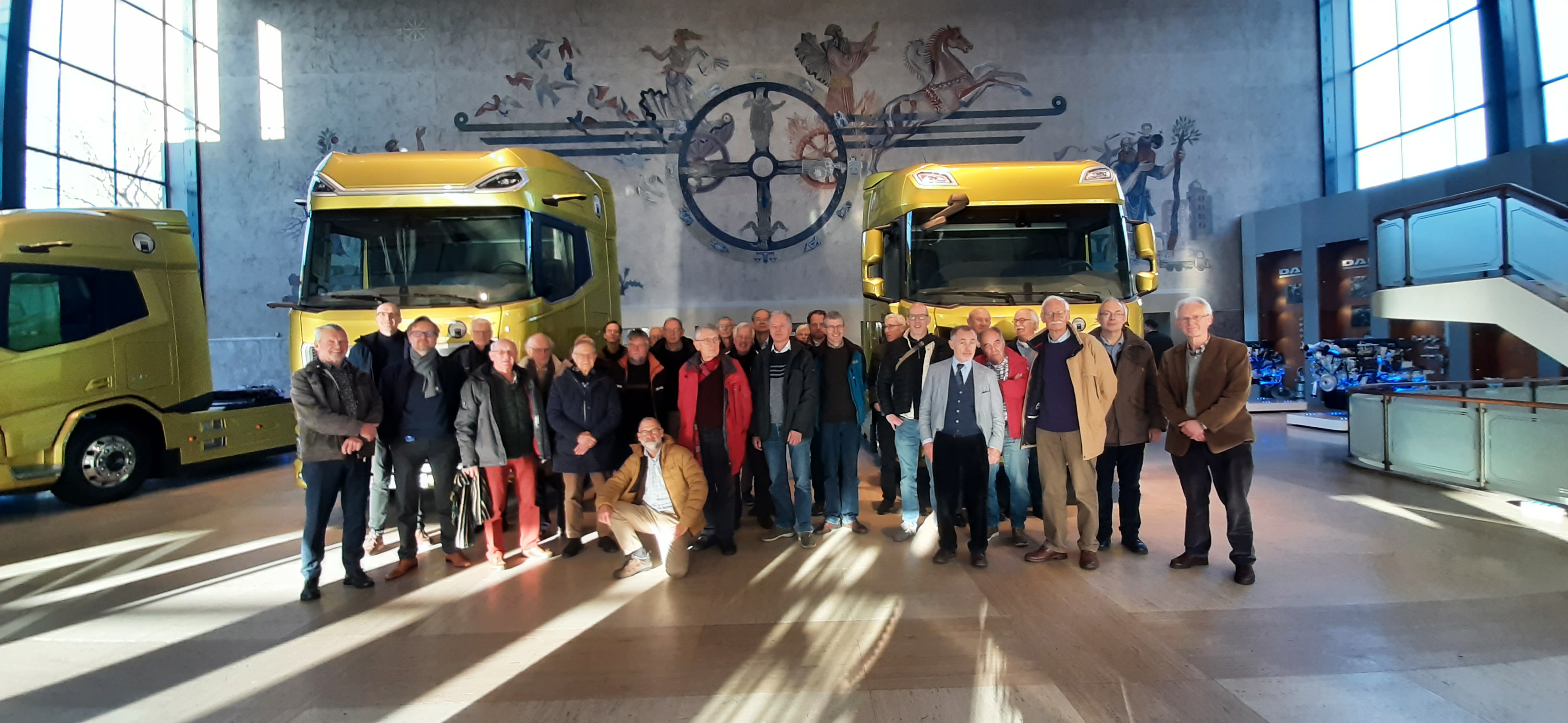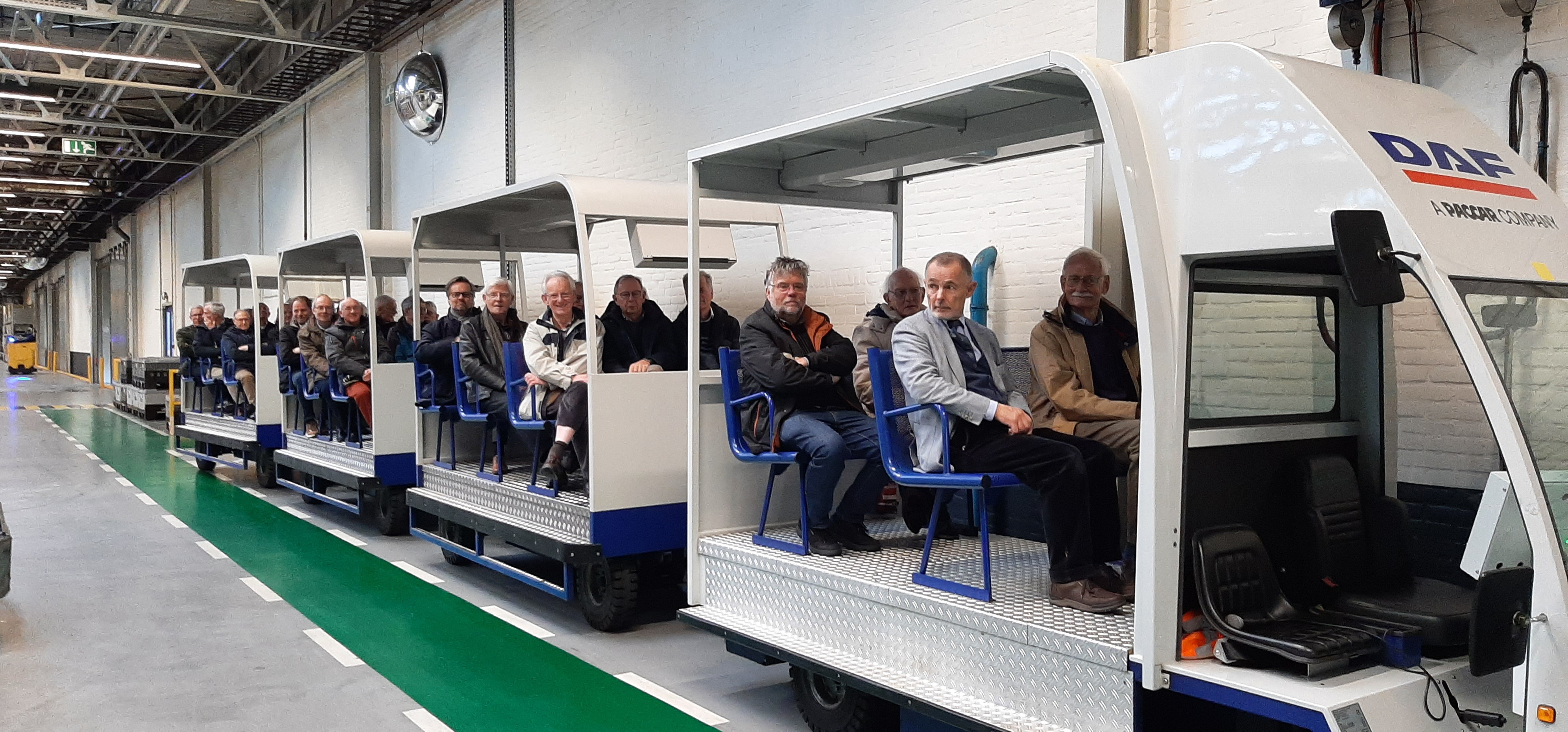
DAF Company visit showing its prize winning H2 truck
DAF Company visit showing its prize winning H2 truck
DAF-Trucks N.V. is a technology company and the premier commercial vehicle manufacturer in Europe.
DAF is a wholly-owned subsidiary of PACCARInc, the global technology leader in the design and manufacturing of premium quality light, medium and heavy-duty commercial vehicles.
PACCAR also designs and produces advanced diesel and electric powertrains, provides financial services and information technology and distributes truck parts related to its principal business.
On Tuesday November 28th we visited DAF Trucks NV in Eindhoven (a subsidiary of PACCAR ).
An interesting tour of the factory was followed by a presentation on the latest generation of DAF Trucks NV. The trucks are designed to lower the energy usage and bring more safety and driver comfort.
To make the truck future proof the design allows for the use of various power units ranging from diesel to hybrid, to battery and hydrogen.
In Eindhoven an Internal Combustion Engine (ICE) was converted to (green) hydrogen fuel.
The DAF XF H₂ Innovation Truck was honored with the ‘Truck Innovation Award 2022’. Rauol-Wijnands discussed the design of the H2 engine and the experience with the truck. The demonstration of the engine had a significant impact on the discussion on future emission requirements in the EU.
Ralph Kwakernaak and Dirk-Jan de Jong contributed to the Q&A at the end of the session. It was emphasized that a huge effort is needed to realize an emission-free transportation system! The visit was organized by Royal Netherlands Society of Engineers (KIVI) Department Electrical Engineering in cooperation with Royal Netherlands Society of Engineers (KIVI) Region-South.
Thanks to Raoul Wijnands for making the visit possible.

Exploring the Hydrogen Internal Combustion Engine
While PACCAR is exploring fuel cell technology, DAF is developing an Internal Combustion Engine running on hydrogen.
Compared to the fuel cell hydrogen solution, the combustion engine option has transient capabilities (eliminating the need for a large energy storage system).
Other advantages include the lower cooling capabilities needed and lower sensitivity to hydrogen purity.
Using hydrogen as a fuel means that in many areas, use can be made of an existing distribution network: from green electric power generation to the location where it is needed. In addition, one should not forget that we in Europe have extensive knowledge and a comprehensive manufacturing footprint in the combustion engine technology.
The European truck industry has commonly expressed the aim to refrain from using fossil fuels for their commercial vehicles as from 2040. Despite, thanks to for instance hydrogen technology, the internal combustion engine still offers huge potential for the further future, especially in the heavy-duty long haul transport segment.
Detailed report by Arno Bartsch:
On Tuesday November 28th, the Electrical Skills Group of KIVI Engineering Society have scheduled a company visit event at the DAF Trucks Eindhoven facilities, with an audience of about 30 participants.
An impressive picture of the various high-end activities could be handed out through a sequence of three consecutive presentations: a manufacturing plant guided tour, an overview on the innovative features of the latest truck ranges, and then also a discussion on the hydrogen fuelled internal combustion engine H2-ICE as fitted in the prize winning heavy duty demonstrator vehicle. These minutes summarize of what could be discovered.
Manufacturing Plant:
The production processes are split out over three factory buildings in following complementary stages:
• The Engine Manufacturing Hall, with machining of head and gearwheels, assembly of parts and blocks, washing and painting, end-of-line cranking, coding and controls of quality.
• The Sheet Metal Workshop, with its heavy equipment for pressing, cutting, bending, rounding, and welding of various plate components like for chassis, bumper, exhaust.
• The Complete Truck Assembly Factory, starting with the customer tailored build of the ladder frame, each with a unique drilling pattern. Its painting and then marrying with engine, transmission, aftertreatment box, cooling loop, soundproofing cover, wiring loom, and completed axles and cabin, both these two subsystems are produced in the nearby Westerlo factory.
And then finalisation of the running vehicle with calibration of speed and tacho, controls of brakes, and inspection of quality.
As every truck has a its own frame-based configuration, the routing of their dedicated parts is tracked through individual matrix code. Just-In-Time delivery of parts and kanban logistics add up to limitation of on-site stocks. Six-sigma methods support improve of quality. This factory tour leaves the visitor with the appreciation of a cleaned-out and fine-synchronised process cadence.
New Generation Truck Features:
In a second session, Mr. Raoul Wijnands, Manager Vehicle Testing, took us through a review of a number of characteristics of the New Generation XF, XG, and XG+ truck series. Development requirements are driven by current main constraints in the field of Global Climate Change, Local Air Quality, Driver Safety and Comfort, and Vulnerability of Road Users.
Solutions for reaching objectives on Emissions and Energy Supply are offered by a wide range of possible powertrains the vehicles can host: the Diesel ICE, the Diesel Hybrid in Mild- or PlugIn- configurations, the Battery Electric Vehicle BEV, and the Hydrogen fuelled ICE or Fuel Cell Electric Vehicle FCEV.
Extended Aerodynamic Studies have led to a 19% reduction in drag, achieving up to 6% improvement in fuel economy, by special attention given to Front Inclination, Wind Screen Curving, Flow Separation Avoidance, Wind Angle Robustness, Wheel Bay Covers, Underhood Flow, Roof Shape, Accessory Disturbances, Sealings.
Security issues are enhanced by Front End Architecture, Passive Driver Safety Features, as well as Advanced Driver Assistance Systems. View has improved through Low Windscreen Beltline, Kerb View Door Window, and Corner Vision View Camera. In a frontal crash the Pro Cabin Displacement throws the cabin to the back, in conjunction with the ripping Front End Crash Brackets and the Rear Crash Deformation Zone that is then absorbing the cabin backwards move. The ADAS consists of a Lane Departure Warning and a pretty large number of Brake Assist Systems for the low speed and parking manoeuvres.
This all then adds up to a very sophisticated package, building a state-of-the-art vehicle for upcoming roads.
Hydrogen Internal Combustion Engine:
The optimal choice of best adapted powertrain technology for a cleaner transport application today is driven by the trade-off between drive range autonomy versus cargo load capacity, and obviously acquisition- and running costs. For the short range urban distribution, the battery of the BEV offers sufficient autonomy with zero-level local emissions. The national distance transport can be optimised with the FCEV for the light- and mid- duty applications, and with the ICE Hybrid PlugIn for the larger more torque demanding trucks.
The international long distance drives currently require the mass energy density of the liquid-type carriers in conjunction with the ICE, like the Diesel, the Renewable Hydrotreated Vegetable Bio Oils, the Synthetic DropIn eFuels, the H2.
The advantages of the use of H2 in the ICE instead of in the FCEV reside within:
• The mature base equipment with lower cost of parts and complexity of integration: at iso-power the FCEV ends up at about twice the price as the ICE.
• No need for an additional battery pack
• A straight-forward cooling system
• The lower sensitivity to the quality of the H2
• The lower need for high accurate filtration of the fresh air
• The fast transient response
• An improving efficiency at increasing loads
• The very high payload carriability: below 150kW the FCEV is a well-adapted solution, beyond 200kW the ICE looks more fitted to the requested power levels.
A prototype XF vehicle with a H2-ICE has been developed as a showcase demonstrator and released in 2022. Main characteristics were handed out by Mr. Ralph Kwakernaak and Dirk-Jan De Jong.
The PACCAR MX13 base engine block got the compression ratio adapted to 12.5. It is equipped with a multi-point port fuel injection system with 6 hydrogen dedicated injectors, direct injection is still under investigation. Together with the very quick diffusion capacity due to the low mass density of H2 this then promotes a very favourable air-fuel mixing.
Boost pressure levels have increased up to 3.5bar through use of a responsive electrical compressor in conjunction with a VNT-turbocharger. End-of-compression pressures move up to about 120bar, combustion pressures are hitting 150bar. Flame temperatures consequently are relatively low, NOx formation in the lean burned mixture is moderate.
The very wide flammability range allow for poor mixture combustion, leading to lower wall heat losses and improved cycle efficiency. Self-ignition temperatures being relatively high, start of ignition requires increased initial spark plug voltage. However, as the laminar flame velocity is pretty fast, further spark ignition energy can be reduced. Any high pressure gradient noises were kept within limits. Issues with potential combustion irregularities like pre-igniting, knocking, backfiring, were not flagged.
In the truck the engine is running with a ( derated ) 1050Nm/140kW max performance level, on the dyno test rig it was measured at 1700Nm/220kW. The on-board storage of the 10 to 14kg H2 is currently being carried out at 350bar gas-compressed, alternatives at 700bar gaseous or at -250°C liquified are being looked at.
The promising result of this concept in the demonstrator truck invites for further exploration of the H2-ICE powertrain. Possibilities for a larger scale application depend strongly on the density of the fuel distribution network, national- as well as continental- wide.
Currently in Netherlands there are only a handful of filling stations, insufficient so far for customer usage. Availability of H2 for road transport is competing with important demands like within process-industries and other aviation. Future directions for energy infrastructure need to be developed by continuous exchange on experiences gained in the industry on one side and support and priorities set by legislation on the other hand.
by Arno Bartsch - Maastricht
Note : this announcement is written in English to also welcome English-speaking engineers from the Eindhoven area


Links
Ready for the fully electric future
DAF Company visit showing its prize winning H2 truck
DAF-Trucks N.V. is a technology company and the premier commercial vehicle manufacturer in Europe.
DAF is a wholly-owned subsidiary of PACCARInc, the global technology leader in the design and manufacturing of premium quality light, medium and heavy-duty commercial vehicles.
PACCAR also designs and produces advanced diesel and electric powertrains, provides financial services and information technology and distributes truck parts related to its principal business.

Exploring the Hydrogen Internal Combustion Engine
While PACCAR is exploring fuel cell technology, DAF is developing an Internal Combustion Engine running on hydrogen.
Compared to the fuel cell hydrogen solution, the combustion engine option has transient capabilities (eliminating the need for a large energy storage system).
Other advantages include the lower cooling capabilities needed and lower sensitivity to hydrogen purity.
Using hydrogen as a fuel means that in many areas, use can be made of an existing distribution network: from green electric power generation to the location where it is needed. In addition, one should not forget that we in Europe have extensive knowledge and a comprehensive manufacturing footprint in the combustion engine technology.
The European truck industry has commonly expressed the aim to refrain from using fossil fuels for their commercial vehicles as from 2040. Despite, thanks to for instance hydrogen technology, the internal combustion engine still offers huge potential for the further future, especially in the heavy-duty long haul transport segment.
Note : this announcement is written in English to also welcome English-speaking engineers from the Eindhoven area
Our host will be Raoul Wijnands Project Manager at DAF.
Parking your car
Due to the limited parking space on the DAF site, it is preferable to use public transport or park your car somewhere nearby.
Links
Ready for the fully electric future
Tekst voor de Report, als deze door DAF is goedgekeurd
